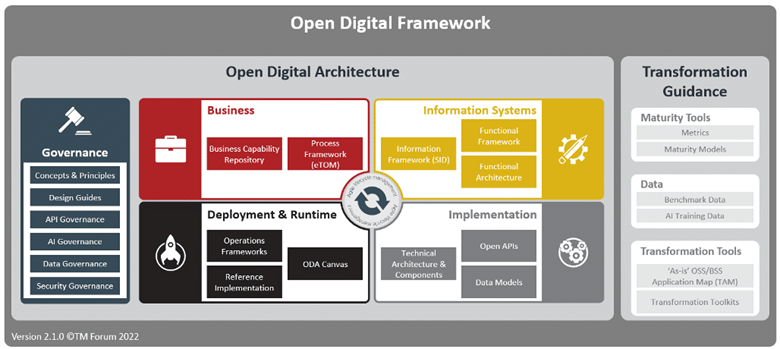In the ever-evolving landscape of telecommunications, the rapid pace of technological advancements often outstrips the adaptability of existing systems. Legacy architectures, should swiftly adapt to new technologies and meet the escalating demands of consumers and businesses, leading to the emergence of the promising concept of Open Digital Architecture (ODA), to revolutionize network infrastructures and operations.
Emergence of ODA
Telecom operators face an uphill battle due to the custom-built systems with different standards and technologies that challenges the whole industry to collaborate between systems and continuous development, required in today’s dynamic environment. The complexity of integrating new services and technologies into these traditional frameworks has become a bottleneck, impeding innovation and responsiveness.
ODA stands as a solution to these challenges, offering a cohesive and adaptable architecture that enables seamless communication and collaboration in a fast-paced technological environment. This article delves into the essence of ODA and its integration with Operating Support System (OSS), elucidating the benefits and operational efficiency brought about by their convergence.

Figure 1: Open Digital Framework (ODF), Version 2.1.0 TM Forum 2022
Understanding ODA and OSS
Open Digital Architecture (ODA) embodies an open and flexible framework designed to modernize telecom networks. It facilitates interoperability, allowing various systems and applications to integrate and communicate efficiently. ODA emphasizes standardization while leaving room for innovation, ensuring adaptability without sacrificing stability.
Operating Support System (OSS) encompasses the software and infrastructure responsible for managing and executing network operations. It handles crucial functions like network monitoring, service provisioning, and customer support. OSS plays a pivotal role in ensuring the smooth functioning of telecom services.
Integrating ODA with OSS brings several advantages, including:
- Seamless Integration:
ODA and OSS integration is fundamental for modern telecom networks to communicate effectively and cohesively. Traditionally, telecom networks relied on various isolated systems and technologies that often struggled to work together seamlessly. With the convergence of ODA and OSS, these diverse systems can communicate efficiently, reducing complexities in network management.
How It Works:
- Unified Communication Protocols: ODA facilitates standardized communication protocols that enable different systems within the network to understand and interact with each other more effectively.
- Interoperability: By adhering to common standards and interfaces, ODA and OSS can interoperate, ensuring that disparate components, applications, and services can work together without conflicts.
- Reduced Silos: Integration minimizes the existence of data and operational silos, allowing for more holistic management and utilization of resources across the network.
Benefits:
- Efficient Operations: Seamless integration streamlines processes, reducing the need for manual interventions and decreasing the chances of errors or operational bottlenecks.
- Improved Service Quality: By ensuring smooth communication between systems, the integrated ODA and OSS can enhance service delivery and customer experience.
- Scalability:
Scalability refers to the ability of the network architecture to accommodate growth and increased demands without compromising performance or incurring substantial costs.
How It Works:
- Resource Allocation: The combined architecture of ODA and OSS allows for efficient allocation and utilization of resources in response to changing demands.
- Elasticity: ODA’s open and flexible nature enables the network to scale up or down seamlessly, ensuring that resources can be allocated dynamically based on real-time requirements.
- Support for Growth: As demands increase, operators can expand services and infrastructure without significant overhauls or disruptions.
Benefits:
- Cost-Efficiency: Scalability enables operators to adjust resources as needed, preventing over-provisioning or underutilization, thus optimizing costs.
- Enhanced Performance: Network scalability ensures that performance remains consistent even during periods of high demand, preventing service degradation.
- Agility:
Agility refers to the network’s ability to adapt swiftly to changes in technology, market dynamics, and consumer needs.
How It Works:
- Rapid Deployment: ODA and OSS integration allows for quick implementation and deployment of new technologies or services without extensive reconfiguration.
- Adaptive Infrastructure: The architecture’s agility enables operators to pivot and adopt emerging technologies or business models promptly.
- Faster Innovation: With streamlined processes and interoperability, telecom operators can innovate and bring new services to market faster.
Benefits:
- Competitive Edge: Agility empowers operators to stay ahead in a fast-paced market by responding rapidly to evolving consumer demands and technological advancements.
- Market Responsiveness: Swift adaptation allows operators to capitalize on new opportunities, making them more responsive to market shifts.
- Flexibility:
Flexibility in ODA arises from striking a balance between standardization and innovation, allowing for both stability and room for new developments.
How It Works:
- Standardized Framework: ODA sets common standards that provide a stable foundation for operations while ensuring interoperability.
- Room for Innovation: While maintaining standardization, ODA leaves space for innovation, enabling the introduction of new services or technologies without disrupting the existing infrastructure.
Benefits:
- Innovative Potential: The flexibility of ODA encourages continuous innovation, allowing operators to introduce new services and technologies that align with market demands.
- Interoperability: By maintaining interoperability, even with new innovations, ODA ensures that new services can seamlessly integrate into the existing network environment.
Conclusion
The integration of ODA and OSS is pivotal for the telecommunications industry, as it brings about a network architecture that is not only seamless, scalable, and agile but also flexible enough to accommodate constant innovation and future advancements.
As telecommunications move towards a more integrated and standardized future, companies like TTG are at the forefront of this transformation. TTG is an active member of the TM Forum, contributing to the development of Open APIs and embracing ODA principles. With 186 vendors, TTG stands committed to building and marketing products consistent with ODA, ensuring a future-ready network architecture, to build tomorrow’s networks today.




